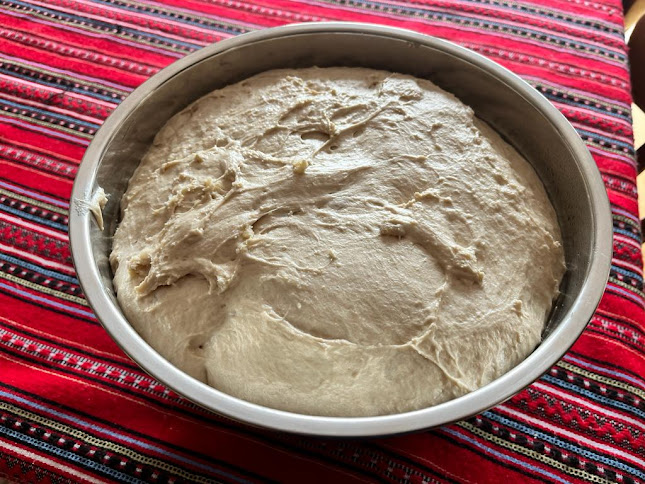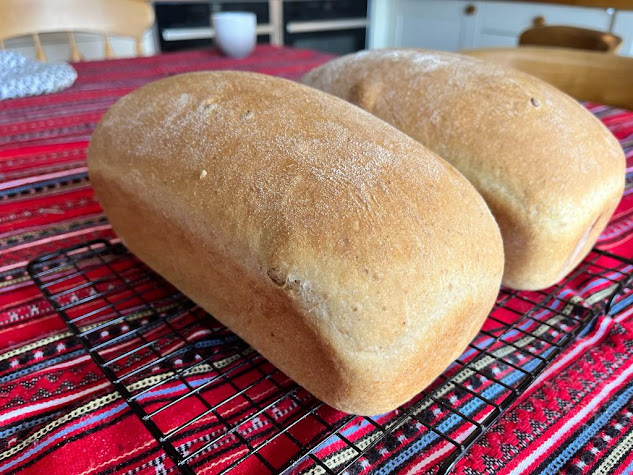The Turnipseed Loaf from Indiana
Welcome to another step-by-step recipe from BreadClub20. Why not drop by our main Facebook page by clicking here.... If you like what you see and enjoy the recipe, we hope you join us by 'Liking' and 'Subscribing'.
Bernard Clayton in 'New Complete Book of Breads' (Simon and Schuster 1973) cites a loaf made by twin sisters, Ola and Minnie Turnipseed of Monticello, Northern Indiana. It's unusual bread in that it's made using a hop starter.
This deserved more investigation.
The Logansport Press of Logansport, Indiana tells us that Ola Turnipseed died in 1972, survived by her sister, Minnie, with whom she lived. Minnie lived until 1981. They were two of eight children born to William Turnipseed (1849 - 1908) and Alice Eliza Harvey (1857 - 1939) and Minnie, unmarried, was the last of the family to pass on.
Unusual as it sounds, Turnipseed is not an uncommon surname in the Southern States. Originally from the German-speaking part of Switzerland, the family name of Rebsamen or Rübasamen can be traced back to the 15th century. The name was translated to Turnipseed around the time of the American Revolution.
As a surname, it's ranked as the 12,683rd most popular surname in the US.
Anyway, back to Ola and Minnie. They were spinsters, living in Headlee, Cass Township. Clayton describes their cooking prowess as 'legendary'. They opened their home as an unofficial restaurant and the waiting list was long. It's worth sharing Clayton's experience:
"Ola and Minne Turnipseed..cooked and served dinners for guests in their kerosene-lit home for more than thirty years.
I had taken my family, including grandsons, to the home for one of the Turnipseed noontime dinners....When the meal had been served on platters down the center of the table, the sisters pulled up chairs to talk. The old dining room was quite dark at midday and one of the sisters was quite deaf and both spoke in rather loud voices."
The Turnipseed loaf was baked on a wood-and-corncob-burning stove and the dough is leavened with a hop starter.
The Monticello Herald Journal recently published an article on a local photographer, Jacob Charles Shaver. His business was bought out by Robert P. Stallard of Lafayette.
"Stallard’s claim to fame in White County was his marriage to a White County gal from the Sitka area. In December 1920, Stollard married Lacie Turnipseed.
Now, what is spectacular is that Lacie was the sister of the “cookin’ sisters,” Ola and Minnie. I can only hope that Lacie had the same talents for cooking as her famed sisters."
Big thanks to Cheri Shelhart, Editor (Monticello Herald Journal), for getting back to me with answers to my queries and really useful source information.
So, there we go.. that's part of the story of Ola and Minnie Turnipseed..all we need now is to recreate their signature loaf. Thankfully, they left behind them both the ingredients and the process.
Let's bake it...It's in three stages:
Stage 1 : Make a Hop starter
Stage 2 : Use the starter to make a Sponge
Stage 3 : Use the Sponge to make the Dough.
Stage 1 : THE HOP STARTER
(This quantity of hop starter will make 4 x 2lb loaves in total. Please note : this recipe is for 2 x 2lb loaves)
If you can..source fresh hops rather than pelleted. Hop season is August to September.
710 gms water
One quart of fresh hops OR 2½ ozs of dried pelleted hops
80 gms cornmeal or polenta
410 gms mashed potatoes
50 gms muscovado sugar
10 gms crushed sea salt
Bring the water to a boil and steep the hops for 20 minutes.
Prepare the mashed potatoes (no milk or butter)
Drain the liquid and throw the hop solids away.
Make up the liquid with boiling water to 710 gms again.
In a saucepan, about a third of the water into the cornmeal and stir over medium heat until just starting to thicken. Set to one side.
In a large bowl, add the water, potatoes, cornmeal, sugar and salt and stir well.
Cover and place in a warm place (about 30⁰C or thereabouts) for anywhere from 24 and 48 hours or more until it is bubbly and smells fermented.
Stir every eight hours or so.
When it's frothy and smells fermented, pour it into a large container with a good lid.
Place in the refrigerator for about two days until the solids have separated from the liquid.
Now, with the liquid on the top, stir the whole thing together and the starter is ready to use.
.jpeg) |
| After 48 hours, the starter looks like this... |
 |
| A closer view... |
.jpeg) |
| Give it a stir and you'll see fermenting bubbles... |
 Decanted into a jar, sealed and ready for a couple of days in the refrigerator.. waiting for it to separate and settle. | ||
Stage 2: THE SPONGE
270 gms of stirred hop starter
470 gms tepid water
380 gms strong bread flour
10 gms muscovado sugar (or cane sugar)
Stir all the ingredients together, cover and place in a warm place overnight.
It's ready to use.
Stage 3 : THE DOUGH
512 gms strong bread flour (approximately - possibly more - watch the dough not the measurements)
95 gms vegetable shortening or lard
15 gms crushed sea salt
10 gms muscovado sugar
1 teaspoon melted butter (for brushing on the finished loaf)
Knock out the air in the sponge and stir in the shortening, salt and three-quarters of the flour and the sugar.
Mix well and begin to knead. If necessary, add more flour to make the mix come together into a fairly sticky dough.
Keep an eye on the flour - you may not necessarily use all the flour, although it's highly likely that you will - and may need a little more.
Remember, this will prove to be a sticky dough - add just enough flour to make it manageable. Don't over-flour - you'll be able to transfer it to a lightly-oiled bowl if your hands are wet...or oiled.
When the dough has doubled, tip it out onto a lightly floured board. Weigh the dough and divide it into two equal portions. Let them rest for about five minutes.
Shape and place into loaf tins. Half-fill the tins and then proof until the dough has risen so that the shoulders of the dough are level or slightly above the top of the sides of the tins. It may well take an hour - it depends on the temperature of the room. Don't rust the clock - watch the dough.
Preheat the oven to 190⁰C.
Mist lightly with water before baking.
Bake for 15 minutes at 190⁰C before dropping the heat to 180⁰C for a further 15 - 20 minutes or until the bread is golden brown and hollow when tapped on the underneath.
Turn the bread out and brush it with the melted butter.
Wait until it cools before slicing.
Crumb shot and Verdict?
Sliced thinly, the crumb is light and airy. This is a lovely soft bread. There is an ever so slight sharpness, a maturity, that comes from the hop starter - but it's certainly not unpleasant and, actually, I found it pleasant. This would make a lovely sandwich and great toast.
Happy baking and thank you, Ola and Minnie Turnipseed....your legend lives on.




.png)



.png)



.jpeg)

.jpeg)
.jpeg)







Comments
Post a Comment